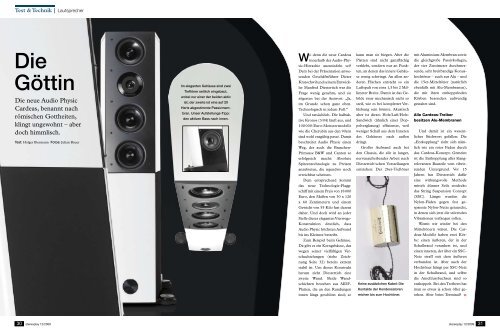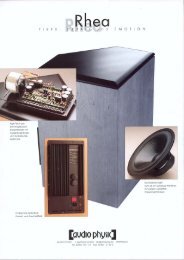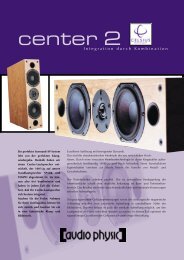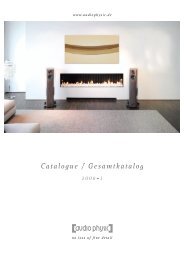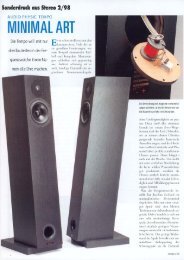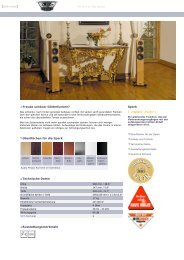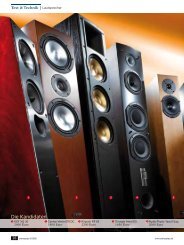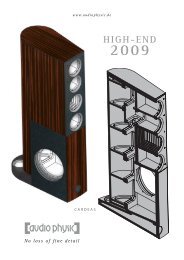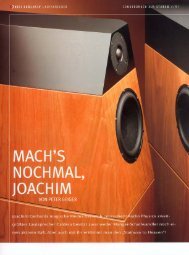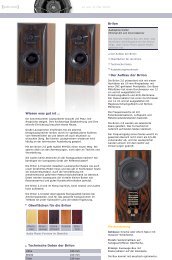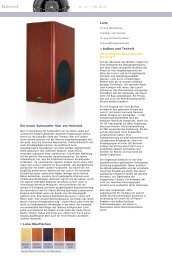Die Göttin - Audio Physic
Die Göttin - Audio Physic
Die Göttin - Audio Physic
You also want an ePaper? Increase the reach of your titles
YUMPU automatically turns print PDFs into web optimized ePapers that Google loves.
Test & Technik | Lautsprecher<br />
<strong>Die</strong><br />
<strong>Göttin</strong><br />
<strong>Die</strong> neue <strong>Audio</strong> <strong>Physic</strong><br />
Cardeas, benannt nach<br />
römischen Gottheiten,<br />
klingt ungewohnt – aber<br />
doch himmlisch.<br />
Test: Holger Biermann Fotos: Julian Bauer<br />
Im eleganten Gehäuse sind zwei<br />
Tieftöner seitlich eingebaut,<br />
wobei nur einer der beiden aktiv<br />
ist; der zweite ist eine auf 20<br />
Hertz abgestimmte Passivmem-<br />
bran. Unser Aufstellungs-Tipp:<br />
den aktiven Bass nach innen.<br />
Wo denn die neue Cardeas<br />
innerhalb der <strong>Audio</strong>-<strong>Physic</strong>-Hierachie<br />
anzusiedeln sei?<br />
Dem bei der Präsentation anwesenden<br />
Geschäftsführer <strong>Die</strong>ter<br />
Kratochwil und seinem Entwickler<br />
Manfred <strong>Die</strong>stertich war die<br />
Frage wenig genehm, und sie<br />
zögerten bei der Antwort: „Ja,<br />
im Grunde schon ganz oben.<br />
Technologisch in jedem Fall.“<br />
Und tatsächlich. <strong>Die</strong> halbaktive<br />
Kronos (3/04) läuft aus, und<br />
100 000-Euro-Monstermodelle<br />
wie die Cherubin aus den 90ern<br />
sind wohl entgültig passé. Damit<br />
beschreitet <strong>Audio</strong> <strong>Physic</strong> einen<br />
Weg, der auch die Branchen-<br />
Primusse B&W und Canton so<br />
erfolgreich macht: Absolute<br />
Spitzentechnologie zu Preisen<br />
anzubieten, die irgendwo noch<br />
erreichbar scheinen.<br />
Dem entsprechend kommt<br />
das neue Technologie-Flaggschiff<br />
mit einem Preis von 18 000<br />
Euro, den Maßen von 30 x 120<br />
x 60 Zentimetern und einem<br />
Gewicht von 55 Kilo fast dezent<br />
daher. Und doch wird an jeder<br />
Stelle dieser eleganten Vierwege-<br />
Konstruktion deutlich, dass<br />
<strong>Audio</strong> <strong>Physic</strong> höchsten Aufwand<br />
bis ins Kleinste betreibt.<br />
Zum Beispiel beim Gehäuse.<br />
Da gibt es ein Kerngehäuse, das<br />
wegen seiner vielfältigen Verschachtelungen<br />
(siehe Zeichnung<br />
Seite 32) bereits extrem<br />
stabil ist. Um dieses Konstrukt<br />
herum zieht <strong>Die</strong>stertich eine<br />
zweite Wand. Beide Wandschichten<br />
bestehen aus MDF-<br />
Platten, die an den Rundungen<br />
innen längs geschlitzt sind; so<br />
kann man sie biegen. Aber die<br />
Platten sind nicht ganzflächig<br />
verklebt, sondern nur an Punkten,<br />
an denen das innere Gehäuse<br />
wenig schwingt. An allen anderen<br />
Flächen entsteht so ein<br />
Luftspalt von etwa 1,5 bis 2 Millimeter<br />
Breite. Damit ist das Gebilde<br />
zwar mechanisch nicht so<br />
steif, wie es bei kompletter Verklebung<br />
sein könnte. Akustisch<br />
aber ist dieses Holz/Luft/Holz-<br />
Sandwich (ähnlich einer Doppelverglasung)<br />
effizienter, weil<br />
weniger Schall aus dem Inneren<br />
des Gehäuses nach außen<br />
dringt.<br />
Großer Aufwand auch bei<br />
den Chassis, die alle in langer,<br />
nervenaufreibender Arbeit nach<br />
<strong>Die</strong>s tertich‘schen Vorstellungen<br />
entstehen: Der 26er-Tieftöner<br />
mit Aluminium-Membran sowie<br />
die gleichgroße Passivkollegin,<br />
der vier Zentimeter durchmessende,<br />
sehr breitbandige Konushochtöner<br />
– auch aus Alu – und<br />
die 15er-Mitteltöner (natürlich<br />
ebenfalls mit Alu-Membranen),<br />
die mit ihren entkoppelnden<br />
Körben besonders aufwendig<br />
gestaltet sind.<br />
Alle Cardeas-Treiber<br />
besitzen Alu-Membranen<br />
Und damit ist ein wesentliches<br />
Stichwort gefallen: <strong>Die</strong><br />
„Entkopplung“ zieht sich nämlich<br />
wie ein roter Faden durch<br />
das Cardeas-Konzept. Gemeint<br />
ist die Entkopplung aller klangrelevanten<br />
Bauteile vom vibrierenden<br />
Untergrund. Vor 15<br />
Jahren hat <strong>Die</strong>s tertich dafür<br />
eine wirkungsvolle Methode<br />
mittels dünner Seile entdeckt:<br />
das String Suspension Concept<br />
(SSC). Längst wurden die<br />
Nylon-Fäden gegen fest gespannte<br />
Nylon-Netze getauscht,<br />
in denen sich jetzt die störenden<br />
Vibrationen verfangen sollen.<br />
Womit wir wieder bei den<br />
Mitteltönern wären. <strong>Die</strong> Cardeas-Modelle<br />
haben zwei Körbe:<br />
einen äußeren, der in der<br />
Schall wand verankert ist, und<br />
einen inneren, der über ein SSC-<br />
Netz straff mit dem äußeren<br />
verbunden ist. Aber auch der<br />
Hochtöner hängt per SSC-Netz<br />
in der Schallwand, und selbst<br />
die Anschlussbuchsen sind so<br />
entkoppelt. Bei den Treibern hat<br />
man so etwas ja schon öfter gesehen.<br />
Aber beim Terminal?<br />
Keine zusätzlichen Kabel: <strong>Die</strong><br />
Kontakte der Kondensatoren<br />
reichen bis zum Hochtöner. ❯❯<br />
30 stereoplay 12/2009<br />
stereoplay 12/2009 31
Test & Technik | Lautsprecher<br />
„Einfach anhören,“ sagt <strong>Die</strong>stertich<br />
dazu: „Mit SSC klingt<br />
es viel klarer.“ Man darf ihm<br />
glauben, weil die kleinen<br />
Dämp fer in vielen stereoplay-<br />
Tests erstaunlich große Klangstei<br />
gerungen in genau dieser<br />
Richtung brachten.<br />
Wer so konsequent vorgeht,<br />
lässt auch die Frequenzweiche<br />
nicht un-entkoppelt. Zudem<br />
verwirklicht <strong>Die</strong>stertich hier<br />
eine ungewöhnliche Schaltung<br />
(siehe Kasten unten) und lässt<br />
sogar ein wenig Esoterik einfließen:<br />
Auf den Kondensatoren<br />
kleben Gabriel-Chips,<br />
die den Elektrosmog reduzieren<br />
sollen und derzeit in den<br />
Foren heiß diskutiert werden.<br />
Bei <strong>Audio</strong> <strong>Physic</strong> bleibt man da<br />
gelassen: „Wer es nicht hört,<br />
muss es ja nicht kaufen. Für<br />
uns ist es erheblich besser.“<br />
Noch einmal zurück zu den<br />
15er-Mitteltönern. In der Cardeas<br />
arbeiten gleich drei davon.<br />
Der mittlere verarbeitet 350 bis<br />
2700 Hertz; die äußeren laufen<br />
quasi noch im<br />
Bassbereich:<br />
von 100<br />
4<br />
1<br />
3<br />
2<br />
bis 350 Hertz. Und das ist wohl<br />
nicht ganz einfach. <strong>Die</strong> Verzerrungs-Werte<br />
der Cardeas sind<br />
zwar über den gesamten Bereich<br />
sehr niedrig, aber bei 80<br />
und 250 Hertz zeigen die beiden<br />
Tiefmitteltöner Klirrspitzen.<br />
Ebenfalls auffällig ist der<br />
schlanke Tiefton. „Natürlich<br />
können wir auch mehr Bass“,<br />
versichert <strong>Die</strong>stertich. „Aber<br />
die meisten Musikfans haben<br />
kleine Räume, und da versagen<br />
90 Prozent der üblichen Lautsprecher.<br />
Auch unsere.“<br />
Und tatsächlich klang die<br />
bewusst bassarm abgestimmte<br />
Cardeas im stark bedämpften<br />
stereoplay-Hörraum erst ein-<br />
<strong>Die</strong> Cardeas ist bewusst<br />
schlank abgestimmt<br />
mal ungewohnt schlank. Aber<br />
schon bei den ersten Takten<br />
Musik wurde deutlich, dass wir<br />
es hier mit einem Schallwandler<br />
zu tun hatten, dessen leichtfüßige<br />
Feinzeichnung und ungemein<br />
plastische Darstellung<br />
womöglich Maßstäbe setzen<br />
könnte. Wenn nicht dieser<br />
etwas dünnliche Bass wäre...<br />
Doch mit stückweisem Heran-<br />
Der gesamte<br />
hintere Teil (1) ist<br />
dem Bass vorbehalten.<br />
Das<br />
Ge häuse des<br />
Mittelhochtöners<br />
ist speziell<br />
bedämpft (2), die<br />
Bass-Öffnung<br />
extra verstärkt<br />
(3), und im sta -<br />
bilen Sockel (4)<br />
sitzt die Weiche.<br />
Schon die<br />
Anschlussklemmen<br />
verdeutlichen<br />
den highendigen Anspruch: Sie sind<br />
von bester WBT-Qualität und aufwendig<br />
entkoppelt. Durch dieses SSC bleiben mechanische Resonanzen,<br />
die über die Lautsprecherkabel kommen, außen vor.<br />
schieben an die Rückwand<br />
wurde es immer besser, das<br />
Klangbild von unten immer<br />
voller. Bei 40 Zentimeter Abstand<br />
war es dann genug. Und<br />
auf einmal war von allem genug<br />
da: Der sonore Brustton des<br />
Livingston Taylor in seinem<br />
„Isn‘t She Lovely“ genauso wie<br />
die brettharten Bassgitarrenimpulse<br />
des Marcus Miller<br />
(„Panther“) oder die wuchtigen<br />
Paukenschläge bei der<br />
Erich-Kunzel-Interpretation<br />
von Tschaikovskys „1812“. Bei<br />
der richtigen Aufstellung kann<br />
dieser Lautsprecher richtigen<br />
Messtechnik<br />
Für den Techniker kein Unterschied, für<br />
den hörenden Highender sehr wohl:<br />
<strong>Die</strong>stertich baut seine Frequenzweiche<br />
symmetrisch auf. Dass heißt: Kein Treiber<br />
hängt direkt an der Masse des Verstärkers.<br />
Um etwa den Tieftöner vor hohen Signalen<br />
zu verschonen, sitzt normalerweise eine<br />
Spule vor dem Treiber (siehe Schaubild).<br />
Bei den neuen <strong>Audio</strong>-<strong>Physic</strong>-Modellen teilt<br />
<strong>Die</strong>stertich den Spulenwert von beispielsweise<br />
2 Millihenry auf zweimal 1 Millihenry<br />
Tiefgang produzieren – und<br />
bleibt dabei immer präzise.<br />
<strong>Die</strong>se Wiedergabe-Präzision<br />
zieht sich durch bis in die<br />
obers ten Lagen. Hier ist allerdings<br />
nicht die weitverbreitete<br />
preußisch-vordergründige Variante<br />
gemeint, sondern eine<br />
selten gehörte Lockerheit. <strong>Die</strong><br />
Harfe von Friedemanns „Kleiner<br />
Zupfmusik“, gemeinhin ein<br />
harter Prüfstein, meisterte die<br />
Cardeas dank ihrer enormen<br />
Antrittsschnelligkeit souverän,<br />
ohne wie viele andere „schnell“<br />
klingende Lautsprecher ins<br />
Raue zu verfallen. Deshalb<br />
Der etwas andere Weichenaufbau<br />
auf: eine Spule vor und eine hinter dem<br />
Bass. Rein rechnerisch ergibt sich hier kein<br />
Unterschied, und auch die TESTfactory<br />
konnte keinen Unterschied messen. Klanglich<br />
gab es ihn sehr wohl. Zur Überprüfung<br />
seiner These baute <strong>Die</strong>stertich für stereoplay<br />
ein Pärchen Yara Kompakt einmal mit<br />
herkömmlicher und einmal mit „symmetrischer“<br />
Weiche auf. Der Fortschritt war<br />
frappierend – vor allem bei der Stabilität<br />
der Abbildung.<br />
klingt sie so echt. Man muss jedenfalls<br />
kein HiFi-Spezialist<br />
sein, um zu hören, dass das<br />
Pfeifen von Livingston Taylor<br />
über die Cardeas absolut natürlich<br />
klingt oder ihre dreidimensionale<br />
Abbildung geradezu<br />
atemberaubend ist.<br />
Am Ende standen 65 Klangpunkte<br />
auf den Listen der Tester.<br />
Das ist für eine Box unter<br />
20 000 Euro eine kleine Sensation.<br />
Addiert man noch die<br />
stimmigen Proportionen und<br />
das schlüssige Aufstellungs-<br />
Konzept, kann es hier nur ein<br />
Urteil geben: Highlight! ■<br />
<strong>Audio</strong> <strong>Physic</strong> Cardeas<br />
18000 Euro (Herstellerangabe)<br />
Vertrieb: <strong>Audio</strong> <strong>Physic</strong>, Brilon<br />
Telefon: 02961/96170<br />
www.audiophysic.com<br />
Auslandsvertretungen siehe Internet<br />
Maße: B:30,5 x H:119 x T:59,5 cm<br />
Gewicht: 55 Kilogramm<br />
Aufstellungstipp: Der schlanke<br />
Bass erlaubt die Nähe der Rückwand.<br />
Für Räume bis 50 m2 Messwerte<br />
Frequenzgang & Impedanzverlauf<br />
<strong>Audio</strong> Physik Cardeas Frequenzgang<br />
100 dB<br />
axial 10*hoch 30*seitl.<br />
2 Ohm<br />
Impedanzverlauf<br />
50 dB<br />
1 Ohm<br />
10 Hz 100 Hz 1 kHz 10 kHz 40 kHz<br />
Sehr schlanke Abstimmung im Bass<br />
und Grundton. Der Hochtonanstieg<br />
ab 20 kHz sorgt für Transparenz<br />
Pegel- & Klirrverlauf 85 - 100dB SPL<br />
<strong>Die</strong> Klirrspitze bei knapp 300 Hertz<br />
limitiert auch den Maximalpegel<br />
Benötigt für HiFi-gerechte Lautstärke<br />
Verstärker ab 32 Watt an 4 Ohm<br />
Untere Grenzfreq. -3/-6dB 64/46Hz<br />
Maximallautstärke 97 dB<br />
32 www.stereoplay.de www.stereoplay.de stereoplay 12/2009 33<br />
Kondensator 1<br />
Hochtöner<br />
Kleiner Trick, große<br />
Wirkung: Bei der<br />
Cardeas hängt kein<br />
Chassis direkt am<br />
Minuspol des<br />
Verstärkers.<br />
<strong>Die</strong> Schallwand<br />
der Cardeas<br />
wird von einer<br />
Alu-Platte<br />
abgeschlossen.<br />
Das versteift die<br />
Front und sieht<br />
nebenbei noch<br />
richtig gut aus.<br />
Kondensator 2<br />
+-<br />
90 dB<br />
80 dB<br />
70 dB<br />
60 dB<br />
100 dB<br />
90 dB<br />
80 dB<br />
70 dB<br />
60 dB<br />
Bewertung<br />
14<br />
10<br />
6<br />
2 Natürlichkeit<br />
Feinauflösung<br />
Grenzdynamik<br />
Bassqualität<br />
Abbildung<br />
16 Ohm<br />
8 Ohm<br />
4 Ohm<br />
<strong>Audio</strong> Physik Cardeas Pegel- & Klirrverlauf<br />
110 dB<br />
50 dB<br />
20 Hz 50 Hz 100 Hz 200 Hz 500 Hz 1 kHz 2 kHz 5 kHz<br />
8Ω<br />
6Ω<br />
4Ω<br />
3Ω<br />
2Ω<br />
stereoplay Bedarfsprofil<br />
0 20w 100w 500w 1000w<br />
14 15 10 11 15<br />
16W<br />
21W<br />
32W<br />
-<br />
-<br />
Klang 65<br />
0 10 20 30 40 50 60 70<br />
Messwerte 7<br />
Praxis 5<br />
Wertigkeit 9<br />
Absolut stimmige Proportionen treffen<br />
bei der Cardeas auf eine selten<br />
gehörte Transparenz und Leichtigkeit.<br />
Eher für kleinere Räume und für<br />
wandnahe Aufstellung entwickelt.<br />
stereoplay Testurteil<br />
Klang<br />
Absolute Spitzenklasse 65 Punkte<br />
Gesamturteil<br />
sehr gut 86 Punkte<br />
Preis/Leistung überragend<br />
noch mehr Produkte unter:<br />
www.goldkabel.de<br />
GOLDKABEL GmbH info@goldkabel.de<br />
R
Test & Technology | Loudspeaker<br />
The<br />
Goddess<br />
The new <strong>Audio</strong> <strong>Physic</strong><br />
Cardeas was named after a<br />
Roman goddess and does<br />
indeed deliver an unusual,<br />
yet heavenly, sound.<br />
Test: Holger Biermann Fotos by: Julian Bauer<br />
Two woofers are built into the sides<br />
of this elegant cabinet, although<br />
only one of them is active, while the<br />
second acts as a passive radiator,<br />
tuned to 20 Hertz. Our setup tip:<br />
Position the Cardeas so that the<br />
active woofers are facing inward.<br />
30 stereoplay 12/2009<br />
stereoplay 12/2009 31<br />
S<br />
o where does the new Cardeas fit<br />
into the <strong>Audio</strong> <strong>Physic</strong> hierarchy?<br />
Managing director <strong>Die</strong>ter Kratochwil<br />
and chief designer Manfred<br />
<strong>Die</strong>stertich were both present at<br />
the presentation of the new speaker<br />
and struggled with the question,<br />
hesitating before answering:<br />
“Well, in principle it belongs right<br />
at the top, certainly with regard to<br />
its technology.”<br />
And how right they are.<br />
The half active Kronos (3/04) has<br />
come to the end of its time, while<br />
100,000 Euro giant models like<br />
the Cherubin from the 1990s are<br />
dead and buried. Leaving these<br />
behind, <strong>Audio</strong> <strong>Physic</strong> is now<br />
pioneering a new method, one<br />
that has brought huge success to<br />
leading industry figures such as<br />
B&W and Canton, namely<br />
offering leading-edge technology<br />
at prices that somehow remain<br />
within reach.<br />
Correspondingly, this<br />
new technology flagship almost<br />
comes across as modest, costing<br />
18,000 Euro, measuring 30 x 120<br />
x 60 centimetres and weighing 55<br />
kilograms. Nevertheless, everywhere<br />
you look in this elegant<br />
four-way design it is clear that<br />
<strong>Audio</strong> <strong>Physic</strong> have put an extreme<br />
amount of effort into this<br />
loudspeaker, right down to the<br />
finest details.<br />
Take the cabinet, for<br />
example. The core unit is already<br />
extremely solid due to its<br />
multifaceted nested structure (see<br />
diagram on page 32). <strong>Die</strong>stertich<br />
has then surrounded this<br />
construction with a second wall.<br />
Both walls are made of MDF<br />
boards, which have been slit<br />
lengthways on the interior side,<br />
allowing them to be bent and<br />
giving the cabinet its curves. These<br />
boards are, however, not fully<br />
glued together. Adhesive has only<br />
been used in areas where the inner<br />
cabinet resonates slightly. All<br />
other areas contain a gap that is<br />
about 1.5 to 2 millimetres wide,<br />
making the structure less mechanically<br />
stiff than it would be if the<br />
two surfaces were fully glued<br />
together. Nevertheless, this<br />
wooden sandwich with an air<br />
filling (similar to double-glazing)<br />
has more efficient acoustics<br />
because less sound is released<br />
through the cabinet walls.<br />
Major effort has also<br />
been put into the drivers, which, as<br />
required by <strong>Die</strong>stertich’s design,<br />
No additional cable: the capacitor<br />
contacts are long enough to<br />
reach the tweeter.<br />
involved many hours of nerveracking<br />
work. The 10" woofer with<br />
an aluminium cone and the passive<br />
woofer of the same size, the<br />
aluminium cone tweeter with a<br />
1.6" diameter and very broad<br />
spectrum and the 6" midrange<br />
drivers (which, as can be expected,<br />
also have aluminium cones) all<br />
have decoupled baskets and are<br />
extremely intricately designed.<br />
All Cardeas drivers have<br />
aluminium cones<br />
And this is where we<br />
come across an essential keyword:<br />
The “decoupling” is literally a<br />
central thread running through the<br />
entire Cardeas concept. It refers to<br />
the fact that all components that<br />
affect the sound delivered by the<br />
speaker are decoupled from vibrating<br />
mounting surfaces. 15 years<br />
ago, <strong>Die</strong>stertich discovered an<br />
effective decoupling method using<br />
thin rope: the String Suspension<br />
Concept (SSC). These nylon<br />
threads have long since been<br />
replaced by tightly stretched nylon<br />
nets, which are designed to trap<br />
interfering vibrations.<br />
And this brings us back<br />
to the midrange drivers. The<br />
Cardeas models have two baskets:<br />
one external basket, which is fixed<br />
into the baffle, and one internal<br />
basket, which is firmly connected<br />
to its external counterpart by an<br />
SSC net. The tweeter is also<br />
attached in the baffle by an SSC<br />
net; in fact, even the jacks are<br />
decoupled in this manner. Of<br />
course, this kind of decoupling is<br />
known to be used in drivers, but<br />
now it’s used on the terminal too?
Test & Technology | Loudspeaker<br />
“Just have a listen”, is<br />
<strong>Die</strong>stertich’s response, “the<br />
sound is much clearer with<br />
SSC." And this man certainly<br />
knows what he’s talking about,<br />
as was proven by the small<br />
dampers in many stereoplay<br />
tests, resulting in astonishingly<br />
large improvements in sound<br />
clarity.<br />
Indeed, the consistent<br />
approach doesn't stop here: even<br />
the crossover network has<br />
undergone the decoupling<br />
treatment. Furthermore, <strong>Die</strong>stertich<br />
has produced an unusual<br />
circuit for the crossover network<br />
(as shown in the box underneath)<br />
and has even integrated a<br />
somewhat esoteric feature: The<br />
clever Gabriel chips are attached<br />
to the capacitors in order to<br />
reduce electromagnetic radiation<br />
and are currently a hotly<br />
debated topic in several forums.<br />
The <strong>Audio</strong> <strong>Physic</strong> camp remains<br />
unperturbed by these debates:<br />
“If you can’t hear the difference,<br />
you don't have to buy it. We,<br />
however, consider it to be a<br />
significant improvement."<br />
4<br />
1<br />
3<br />
2<br />
Let’s take yet another look at the<br />
6" midrange drivers, three of<br />
which can be found in the<br />
Cardeas. The middle driver<br />
processes from 350 to 2700<br />
Hertz, while the external drivers<br />
are left to cover the bass range of<br />
100 to 350 Hertz. Achieving<br />
such performance doesn't come<br />
easy. The distortion levels of the<br />
Cardeas are indeed very low over<br />
the entire frequency range, but<br />
both of the woofer/midrange<br />
drivers display peaks at 80 and<br />
250 Hertz. The tight bass<br />
response is also quite noticeable.<br />
“Of course we could add more<br />
bass,” assures <strong>Die</strong>stertich, “but<br />
most music fans have small<br />
rooms, in which 90 percent of<br />
conventional speakers fail where<br />
bass is concerned, even ours.”<br />
The Cardeas, designed<br />
to produce a decidedly lean bass,<br />
did indeed deliver an unfamiliar<br />
tight sound at first in our heavily<br />
damped stereoplay listening<br />
room. Nevertheless when the first<br />
The Cardeas is meant to<br />
deliver a tight sound<br />
bars of music came through, it<br />
became clear that we were<br />
dealing with a loudspeaker<br />
with an airy level of detail and<br />
incredible spatial reproduction<br />
The entire<br />
rear section (1) is<br />
dedicated to the<br />
woofers. The<br />
midrange driver<br />
chamber is<br />
specially damped<br />
(2) , the bass<br />
port is doubly<br />
reinforced (3),<br />
and the crossover<br />
sits in a solid<br />
bottom plate. (4)<br />
Even the<br />
connecting terminals<br />
emphasise that this is a<br />
high-end product. The top quality WBT<br />
terminals are intricately decoupled. This SSC<br />
decoupling ensures that mechanical resonances carried<br />
in the loudspeaker cable are kept out of the speaker itself.<br />
that may really be able to establish<br />
new benchmarks. If only that<br />
rather lean bass didn't exist...<br />
Things did, however, constantly<br />
improve as we gradually moved<br />
the speaker closer to the back<br />
wall, with the low frequency<br />
sound developing into deep and<br />
full bass. We stopped moving the<br />
loudspeaker once it had reached a<br />
distance of 40 centimetres from<br />
the wall. Then suddenly, the right<br />
amount of every sound aspect<br />
was present: be it the sonorous<br />
chest tone produced by Livingston<br />
Taylor in his song “Isn’t She<br />
Lovely”, the rock-hard pulsing of<br />
Marcus Miller’s bass guitar<br />
(”Panther”) or the powerful drumbeats<br />
in Erich Kunzel's version of<br />
Measuring Technology<br />
The Rather Di�erent Crossover Construction<br />
Engineers may not notice the di�erence, but<br />
high-end listeners certainly will: <strong>Die</strong>stertich has<br />
designed a symmetrical crossover network. This<br />
means that no driver is directly attached to the<br />
ground of the ampli�er. There is usually a coil<br />
placed in front of the driver in order to protect<br />
the woofer from high signals (see diagram) but<br />
in the new <strong>Audio</strong> <strong>Physic</strong> models, <strong>Die</strong>stertich<br />
splits the coil inductance, for example from one<br />
coil of 2 millihenry into two coils, each with a<br />
value of 1 millihenry, one in front and one behind<br />
Tchaikovsky’s “1812”. When set up<br />
correctly, the Cardeas is perfectly able<br />
to deliver deep punchy bass, whilst<br />
also constantly remaining precise.<br />
This precise sound reproduction<br />
remains impressive right<br />
through to the higher frequencies.<br />
With this, we don’t mean the<br />
ostensible Prussian types of sound<br />
that are so commonly delivered,<br />
but a rarer, more mellow reproduction.<br />
Thanks to its tremendous<br />
dynamic attack, the Cardeas was<br />
able to confidently cope with the<br />
harp in Friedemann’s “Kleiner<br />
Zupfmusik”, which is normally a<br />
hard nut to crack, without causing<br />
it to deteriorate into a rough sound,<br />
as is the case with many other<br />
'quick' sounding loudspeakers.<br />
the woofer. In a purely mathematic sense this<br />
makes no di�erence and the TESTfactory was<br />
also unable to measure any changes. But when it<br />
came to the delivery of sound, the di�erence was<br />
there for all to hear. In order to verify his theory,<br />
<strong>Die</strong>stertich set up two Yara compact speakers for<br />
stereoplay, one with a conventional crossover and<br />
the other with a ‘symmetrical' crossover. The<br />
improvement was striking, especially with regard<br />
to the stability of the sound image.<br />
It is for this reason that the loudspeaker<br />
achieves such an authentic<br />
sound reproduction. You certainly<br />
don't need to be an audiophile specialist<br />
to hear that Livingston Taylor’s<br />
whistling sounds completely natural<br />
when played through the Cardeas, or<br />
to realise that its three-dimensional<br />
sound image is simply breathtaking.<br />
After completing their<br />
tests, our reviewers awarded the<br />
Cardeas 65 sound points. For a<br />
loudspeaker costing less than 20,000<br />
Euro, this result is something of a<br />
sensation. If you then add in the<br />
speaker’s harmonious proportions<br />
and coherent positioning concept,<br />
you can only come to one conclusion:<br />
The Cardeas is a real highlight!<br />
A small trick with<br />
<strong>Audio</strong> <strong>Physic</strong> Cardeas<br />
Distribution: <strong>Audio</strong> <strong>Physic</strong>, Brilon<br />
Telephone: +49 (0)2961/96170<br />
www.audiophysic.com<br />
See website for distributors abroad<br />
Dimensions: W:30,5 x H:119 x D:59,5 cm<br />
Weight: 55kg<br />
Positioning: Due to the slim woofer<br />
design the Cardeas can be placed near<br />
the back wall. For rooms of up to 50 m2<br />
Measurements<br />
Frequency Response & Impedance<br />
<strong>Audio</strong> Physik Cardeas Frequenzgang<br />
100 dB<br />
axial 10*hoch 30*seitl.<br />
2 Ohm<br />
Impedanzverlauf<br />
50 dB<br />
1 Ohm<br />
10 Hz 100 Hz 1 kHz 10 kHz 40 kHz<br />
Very tight adjustment in the woofer and<br />
bass note area. The high frequency increase<br />
from 20 kHz ensures transparency.<br />
Level & Distortion Response 85-100dB SPL<br />
The peak at approximately 300 Hertz<br />
also limits the maximum level.<br />
Requires ampli�ers supplying 32 W into<br />
4 Ohm for HiFi performance levels.<br />
Lower Crossover Frequ. -3/-6dB 64/46Hz<br />
Maximum Level 97 dB<br />
32 www.stereoplay.de www.stereoplay.de stereoplay 12/2009 33<br />
Capacitor 1<br />
Tweeter<br />
a large e�ect:<br />
no driver in the Cardeas<br />
is directly attached<br />
to the ampli�er’s<br />
negative terminal.<br />
+-<br />
The Cardeas<br />
ba�e is<br />
covered by an<br />
aluminium sheet,<br />
which strengthens<br />
the front of the<br />
loudspeaker and<br />
just happens to<br />
look amazing too.<br />
Capacitor 2<br />
90 dB<br />
80 dB<br />
70 dB<br />
60 dB<br />
100 dB<br />
90 dB<br />
80 dB<br />
70 dB<br />
60 dB<br />
Rating<br />
14<br />
10<br />
6<br />
2 Naturalness<br />
Resolution<br />
Dynamics<br />
Woofer Output<br />
Imaging<br />
16 Ohm<br />
8 Ohm<br />
4 Ohm<br />
<strong>Audio</strong> Physik Cardeas Pegel- & Klirrverlauf<br />
110 dB<br />
50 dB<br />
20 Hz 50 Hz 100 Hz 200 Hz 500 Hz 1 kHz 2 kHz 5 kHz<br />
8Ω<br />
6Ω<br />
4Ω<br />
3Ω<br />
2Ω<br />
stereoplay Power Pro�le<br />
0 20w 100w 500w 1000w<br />
14 15 10 11 15<br />
16W<br />
21W<br />
32W<br />
-<br />
-<br />
Sound 65<br />
0 10 20 30 40 50 60 70<br />
Measurements 7<br />
Practice 5<br />
Value 9<br />
The Cardeas with its perfectly matched<br />
proportions delivers transparency and<br />
airy lightness to a degree seldomly<br />
heard. Well-suited for smaller rooms<br />
and near-wall positioning.<br />
stereoplay Test Result<br />
Sound<br />
Absolute Top Class 65 Punkte<br />
Overall Result<br />
Excellent 86 Punkte<br />
Price/Performance outstanding


